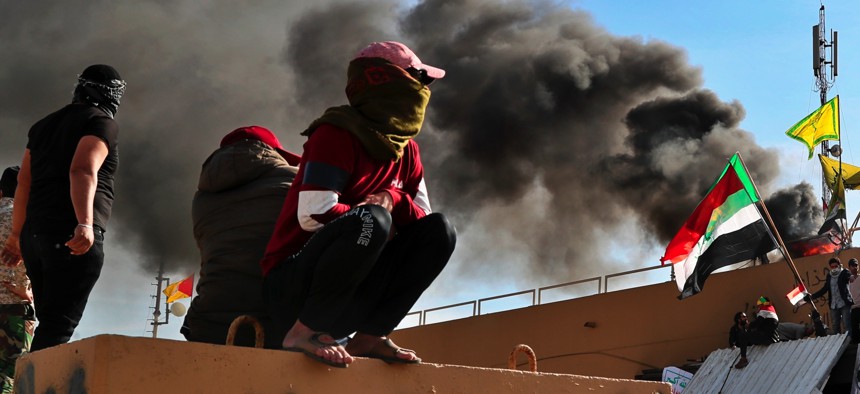
Pro-Iranian militiamen and their supporters set a fire during a sit-in in front of the U.S. embassy in Baghdad, Iraq, Wednesday, Jan. 1, 2020. AP / Khalid Mohammed
In Iraq, the US Gets Hit Where It Hurts
The storming of the U.S. embassy in Baghdad demonstrated that America doesn’t have a monopoly on pressure.
When Iranian student revolutionaries seized the U.S. embassy in Tehran in 1979 and took dozens of American diplomats hostage, it destroyed U.S.-Iranian relations and ruined Jimmy Carter politically. When Islamist militants attacked the U.S. consulate in Benghazi in 2012, killing several Americans including the U.S. ambassador, it became the rallying cry for Republicans (including Donald Trumpand his current secretary of state, Mike Pompeo), who accused Barack Obama and Hillary Clinton of malpractice in their handling of national security.
So when hundreds of supporters of Iranian-backed militias breached the U.S. embassy in Baghdad on Tuesday—setting fires and chanting “Death to America” as American diplomats huddled inside and the compound’s sirens howled—it was more than another spasm of unrest in the course of America’s ill-fated engagement in Iraq. It was a geopolitical gut punch to the Trump administration, conjuring the ghosts of the Iran hostage crisis and Benghazi debacle. And it was a striking reminder (as if we needed another) of just how dangerous the showdown between Iran and the United States has become as it has morphed from a narrow dispute over Trump withdrawing the U.S. from the Iran nuclear deal into a series of broader confrontations across the Middle East.
While Trump and other U.S. officials have accused Iran of orchestrating the storming of the U.S. embassy compound, the extent of the Iranian government’s involvement remains unclear. What is clear is that at least some of the demonstrators were aligned with Tehran-supported Iraqi militia groups, including Kataib Hezbollah, which the Trump administration says was behind a rocket attack on U.S. personnel in the Iraqi city of Kirkuk several days ago that killed an American contractor. The U.S. military then retaliated by conducting air strikes against Kataib Hezbollah’s bases along the Iraq-Syria border and killing 25 militia members, leading to Tuesday’s protests.
The attack on the U.S. embassy has placed Trump in a vulnerable position in part because it raises questions about his performance as commander in chief, which is perhaps what prompted his ally in the Senate, Lindsey Graham, to try to preempt criticism on Tuesday by declaring that in sending Apache helicopters and more marines to secure the diplomatic facility, the president had “put the world on notice” that “there will be no Benghazis on his watch." As the situation at the embassy stabilized, Trump similarly tweeted that “our great Warfighters” and “the most lethal military equipment in the world” had been “immediately rushed to the site,” making his response “the Anti-Benghazi!” (He wrote all this, perhaps prematurely, while protesters are still camped out around the embassy. He also interspersed it, “just for a little change of pace,” with a retweet about ultimate fighting.) Later on Tuesday, Defense Secretary Mark Esper announcedthat the U.S. would deploy about 750 additional troops to the region in the coming days.
Related: Is US Deterrence Against Iran Doomed to Fail?
Related: The Foreign-Policy Parallels Between Trump and the Ayatollahs Are Uncanny
Related: An End to Magical Thinking in the Middle East
The incident will also pile pressure on Trump because the protesters, who have vowed to remain at the embassy until all American troops and diplomats depart Iraq, are in a sense pushing against the open door of Trump’s resistance to being there in the first place. The heavily fortified U.S. embassy in Iraq, the largest American diplomatic facility in the world, is a $750 million testament to the colossal disaster that was the U.S. military intervention to “liberate” Iraq. Trump has condemned George W. Bush’s decision to invade the country and vowed to end America’s endless wars there and elsewhere in the Middle East. The Trump administration, in fact, proposed major staff cuts at the embassy in Baghdad only weeks before it came under assault.
While Trump hasn’t yet reacted to this episode by announcing the withdrawal of the 5,000 U.S. troops still in the country to fight the Islamic State or a drawdown of America’s diplomatic presence there, others have responded by pointing to the exits. The drama at the embassy “should be the final straw in our long occupation of Iraq,” said Benjamin Friedman, the policy director at the think tank Defense Priorities, which advocates for more military restraint in U.S. foreign policy.
As Graham tells it, the U.S. message to Iran and its proxies in recent days has not been that it is ready to retreat. Instead, it’s been that “President Trump, unlike President Obama, will hold you accountable for threats against Americans and hit you where it hurts the most.” But the protests at the U.S. embassy illustrate that Iran and its affiliates can also hit the United States where it hurts most.
That’s what’s so perilous about the fallout from the U.S. exit from the nuclear deal. From Iran’s shooting-down of an American drone in June to its attack on Saudi oil facilities in September to the march on the U.S. embassy this week, hostilities between Washington and Tehran have threatened to escalate out of control even though in theory neither party wants to be drawn into a war. They haven’t been yet, but that doesn’t mean they won’t be. On Tuesday, underscoring this danger, Trump tweeted that Iran would “pay a very BIG PRICE” for what occurred at the embassy. (After clarifying that this was a “Threat,” not a “Warning,” he wished everyone a “Happy New Year!”)
As the Trump administration continues to apply “maximum pressure” on Iran through economic sanctions and other measures in an effort to compel Tehran to strike a new nuclear agreement and curb its aggression in the Middle East, the protesters at the American embassy in Baghdad just served their own sort of notice: The United States doesn’t have a monopoly on pressure.
NEXT STORY: Most-Read of 2020 (So Far)




